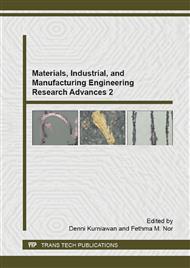p.161
p.166
p.171
p.176
p.181
p.186
p.190
p.195
p.200
Thermal Response of Activated Charcoal Modified Investment Casting Moulds
Abstract:
Direct microwave dewaxing of investment casting moulds is possible at the expense of time and poor heat distribution. Modifying the back-up stucco of investment casting moulds may enhance microwave absorption; however, it may affect its thermal properties. In this study, the effects of adding activated charcoal in the back-up stucco of the investment casting mould were investigated. Samples prepared without and with 25% activated charcoal were tested for differential scanning calorimetry (DSC) and Thermogravimetric analysis (TGA). It was observed that the specific heat capacity is higher in the samples added with activated charcoal. The DSC curves exhibit a smooth trend with no indication of exothermic or endothermic peaks in both samples. The glass transition temperature was also increased from 515.29°C to 582.24°C after modifying the contents. However, the TGA results show no significant difference in mass lost between the two samples that are about 2%. The DSC and TGA curves for both samples show similar patterns indicating that there is very close similarity in their thermal behaviour. Due to that, it can be concluded that the addition of activated charcoal in the back-up stucco does not induce an unusual reaction or thermal behaviour in the moulds.
Info:
Periodical:
Pages:
181-185
Citation:
Online since:
October 2015
Authors:
Keywords:
Price:
Сopyright:
© 2015 Trans Tech Publications Ltd. All Rights Reserved
Share:
Citation:


